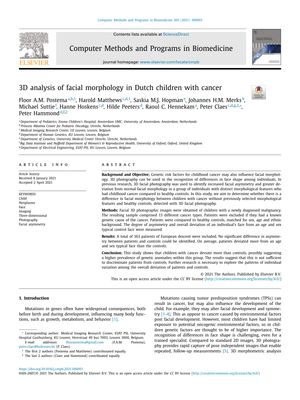3D Analysis of Facial Morphology in Dutch Children with Cancer
June 2021
in “
Computer methods and programs in biomedicine
”

TLDR Children with cancer had slightly more unusual facial shapes than healthy kids, but not enough to easily tell them apart.
In a study involving 163 European children with cancer, 3D facial photography was used to compare their facial morphology to that of healthy controls matched by sex, age, and ethnicity. The study aimed to determine if there were detectable differences in facial shape between the two groups. The results showed that while there was no significant difference in facial asymmetry, children with cancer had a greater overall deviation from a typical face for their age and sex compared to the controls. This suggests that children with cancer may have a higher prevalence of genetic anomalies affecting facial morphology. However, these differences were not pronounced enough to distinguish patients from controls, indicating the need for further research to understand the individual variations in facial morphology among children with cancer.